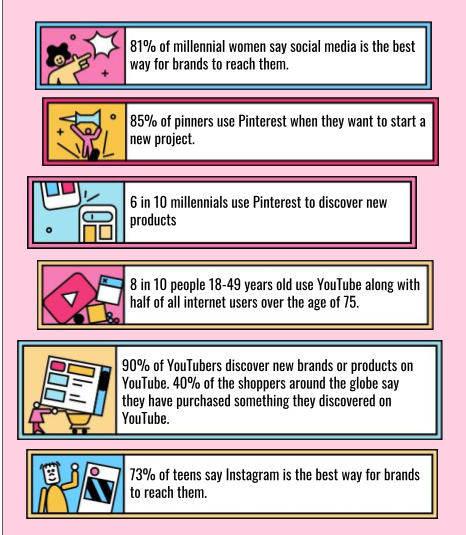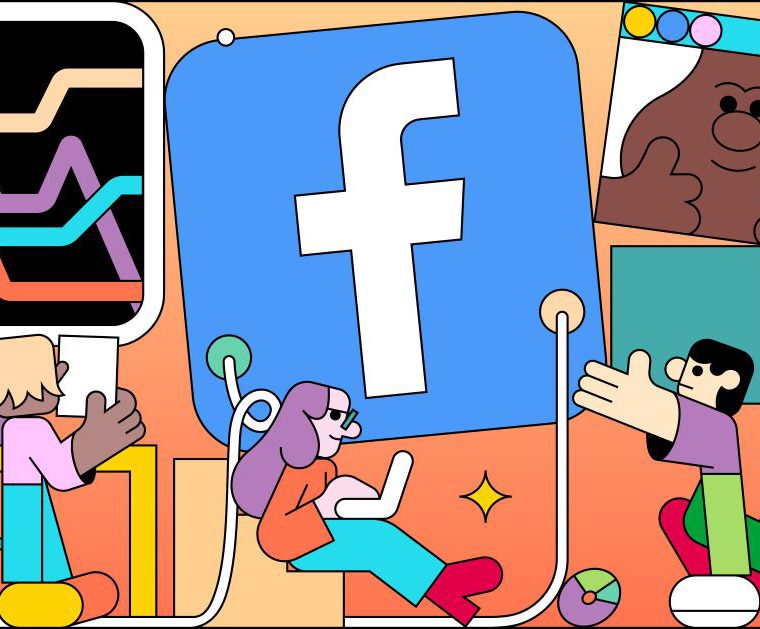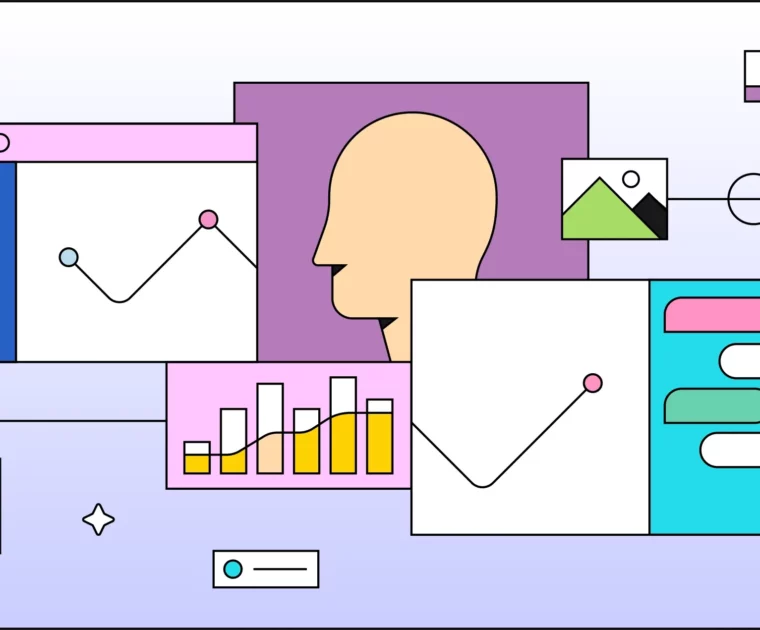Welcome to The Shelf’s complete guide to influencer marketing strategy. If there ever was a sort of Bible for inlfuencer marketing, this would be it. Our marketing team, account managers, and sales team worked hard to put together a virtual encyclopedia of influencer marketing campaign strategies.
Originally, this sucker was more than 10,000 words of content. But we shortened it. A little. Still, this complete-slash-ultimate-slash-A-to-Z guide to social media influencer marketing strategy covers:
- Everything a brand needs to know to justify influencer marketing spend
- Everything the Marketing Manager needs to know to get buy-in from the higher-ups
- Everything the marketing team needs to know to set up and run an influencer marketing campaign
- And everything the demand gen/paid team needs to know about optimizing a live campaign to deliver the best results
Nuff chit-chat. Let’s get started.

What You’ll Find in Our Epic Influencer Marketing Strategy Guide
Influencer Marketing Basics
- What is influencer marketing?
- The benefits of influencer marketing
- Why it works so well
- How it works
Influencer Marketing Strategy
- Setting Influencer Marketing Campaign Goals
- Knowing How to Structure an Influencer Campaign and Create the Best Influencer Marketing Strategy
- Choosing the Right Social Media Platforms for Your Campaign
How to Work with Influencers
- The Different Types of Influencers
- How to Find Influencers for Your Campaign
- Choosing the Right Influencer Partners
- Tips for Nailing Influencer Outreach
- Influencer Marketing Strategy Templates
Sponsored Content Best Practices
- Securing Content Rights
- How to Get the Best Creative Content from Your Influencer Partners
- 7 Things to Consider When Coming Up with Ideas for Your Influencer Marketing Strategy
Influencer Marketing ROI
- Campaign Management
- Which Metrics Should You Track with an Influencer Campaign?
- Optimizing a Marketing Influencer Campaign for Better Influencer Marketing ROI
- What is Whitelisting and How Does it Work?
- Whitelisting vs Boosting vs Dark Posts
Reusing Influencer-Generated Content
- Campaign Management
- Which Metrics Should You Track with an Influencer Campaign?
- Optimizing a Campaign for Better Influencer Marketing ROI
- What is Whitelisting and How Does it Work?
- Whitelisting vs Boosting vs Dark Posts
Influencer Marketing Glossary & Stats
- Influencer Marketing Definitions
- Influencer Marketing Statistics
What is Influencer Marketing?
Influencer marketing has become an increasingly important part of the digital landscape. But what (EXACTLY) is it?
A mommy blogger speaking well of a skin cream that helps reduce the discomfort of her daughter’s eczema? Is it a celebrity endorsement? How do we define it?
How does it really affect your marketing campaigns? How do you create an influencer marketing strategy? More, how do brands translate 💗 Instagram Likes 💗 into conversions?
We’ll get into all of that in this influencer marketing strategy guide, but first, let’s start at the beginning:
That’s because influencers (or creators) are the people others follow, look up to, and keep up with for advice and inspiration – whether the topic is fashion, beauty, finance, tech, gardening, or even more niche interests like car detailing, agriculture, or spelunking!
The Benefits of Influencer Marketing
Influencer marketing is personal… Where paid ads are often thought of as non-personal marketing, influencer marketing is far more personal, and that personal touch increases sales and is the driving force behind the effectiveness of influencer campaigns. Four in ten millennials who follow influencers say they feel like social media influencers know them better than their own friends. How’s that for personal?
Influencer marketing is a more targeted approach… Influencer marketing allows brands to get in front of niched-down segments of their target audience by borrowing the goodwill of the people those audience segments already like, trust, and admire. Sixty-one percent of consumers trust the recommendations that come from micro-influencers and macro-influencers.
Influencer marketing offers strong social proof… Influencers are great at two things: creating compelling content and getting their followers to take an action. Brands that work with influencers are gaining allies who already know how to present ideas, concepts, and visuals to their audience that can get them to respond.
Influencer marketing allows for real-time results… When brands roll out influencer marketing campaigns in stages, they have the opportunity to monitor the campaign performance in real-time to allow the marketing team a chance to optimize campaigns and put more resources behind content that’s performing well. Influencer marketing is also a great way to test messaging before sending ad concepts to print or using them in PPC campaigns.
Influencer marketing is more affordable… Influencer marketing is an all-in-one solution that allows brands to go directly to social media influencers for branded content to promote their product or service, eliminating the need for a creative team whose job is to create the assets for specific campaigns.
Influencer marketing works faster… Influencer marketing has proven to be an effective tool for boosting brand lift across multiple channels. Influencer marketing strategies are a good way to drive traffic back to the brand’s website, talk-up an event, promote a new product, and assemble a catalog of creative, compelling content creation.
Why Influencer Marketing Works So Well (even though we know we’re being marketed to)
We are bombarded every single day with branded messages. Ads abound. There’s a popular stat floating around that the average person sees up to 10,000 ads a day. Well, if we’re seeing more than 5,000 ads a day, and the average person’s only getting six hours of sleep a night, that means during our 18 waking hours, we see 277 ads every hour on the hour, which is about one ad every 4.5 seconds.
For every day in 2019, about 13,560 pieces of influencer-created sponsored content went up on Instagram, according to Statista. Between 2019 and 2022, the influencer market more than doubled in size, going from $6.5B to $15B in value.
Today, nine in ten marketers say they are running or planning to run an influencer marketing strategy campaign in the near future. Influencers seem to have a finger on the pulse of social communities.
So, how do we get ANYTHING done?!!?
Two ways: Adblockers and ad blindness.
Tens of millions of people have taken deliberate steps to make sure they’re not exposed to ads by using ad blockers that are so sophisticated that they even help you skip pre-roll YouTube ads altogether. Something like 44 percent of adults who use the Internet globally also use an ad blocker.
So here’s the question: If people hate ads so much, why does influencer marketing even work on smart consumers and why do brands continue to implement social media influencer marketing strategies?
Short answer: It’s the presentation. Influencer marketing doesn’t disrupt an Instagrammer’s experience like a TV ad interrupts an episode of The Bachelor. And believe it or not, one of the (many) reasons people go to social media in the first place is to learn about new trends, products, brands, and movements.
How Influencer Marketing Works
Influencer marketing integrates pretty seamlessly with your overall digital marketing strategy because it lets brands show up at different touchpoints along the path to purchase. The most effective and best influencer marketing strategies work across multiple platforms.
For every channel you add to your digital marketing strategy, you can improve your ROI and effectiveness by up to 35 percent, according to Analytics Partners. And studies have shown that conversions increase by at least 10 percent for brands that use influencer-generated content in the online purchase path.
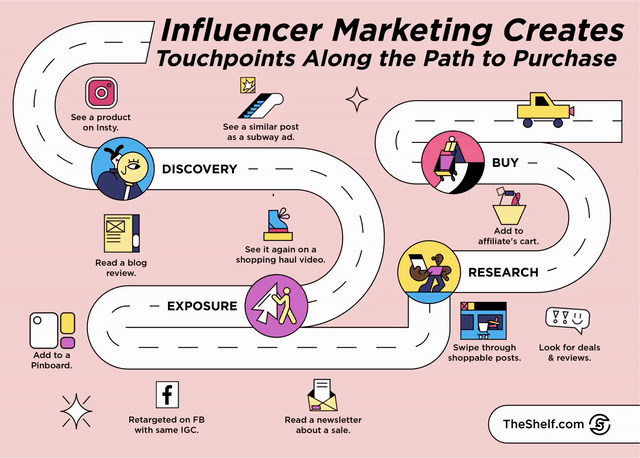
Take a look at the channels identified in the graphic above. All of those channels – the subway ads, the Pinterest board, the newsletter – are access points for different types of influencers to extol the virtues of your brand, creating a kind of echo chamber all across the web.
In the previous section, we included the stat (in the pink chart) that 81 percent of millennial women say social media is the best way to reach them, making social media marketing strategies the key to success. That’s a stat to which most digital marketers would easily subscribe. Well, here are a few more of the answers given by millennial women from that same poll:
- 36 percent say websites they trust are a good way to reach them
- 35 percent say online articles
- 35 percent say email
- 17 percent say online video
Let’s move on to some tactical elements of your influencer marketing campaign strategy to give you a basic understanding of how the puzzle pieces fit together. This will make it easier to understand how threading an influencer marketing strategy throughout your digital marketing activations can help you hit all the important KPIs your brand is targeting this year. (And really, after the year we’ve had, don’t we all just kinda need a win right now?)
Setting Your Influencer Marketing Campaign Strategy Goals
We totally get why some marketers and brands are still giving influencer marketing the side-eye. 😒 There’s a lot of talk about things like earned media value, brand-building, long-term value, playing the long game…
That’s all great, but aren’t you more interested in finding out what part of influencer marketing strategies lines up with ACTUAL business goals – the kind of business goals set by REAL companies? So many brands are still under the misguided notion that influencer marketing is just a brand awareness play when that’s not the case at all. For brands, the value of running an influencer marketing campaign goes far beyond just reach and Likes.
It’s not that you can’t accomplish important business goals by learning how to create an influencer marketing strategy. We’ve run our fair share of influencer marketing campaigns to help clients get more app downloads, boost sales, and drive site traffic AND foot traffic. More often than not, there’s a disconnect between what a brand WANTS to accomplish and how it STRUCTURES its influencer marketing campaign strategies to achieve that end. The former has EVERYTHING to do with the latter.
Influencer marketing strategies need goals. Your campaign goals set the metrics you use to track the success of your influencer campaign.
Whether the goal is to get a new product in front of buyers, get traffic back to your site, or get a catalog of creative assets you can post across your own branded social platforms, a well-planned influencer marketing strategy can help you accomplish REAL marketing goals and move the needle on larger organizational goals.
Knowing How to Structure Your Influencer Marketing Strategy to Hit KPIs
Influencer marketing campaign strategies can (and should) be custom-built to achieve specific goals. Knowing which outcomes you want to see will determine how your campaign is structured and which influencer marketing strategy you use. There are three primary types of campaigns you can use to reach your influencer marketing goals – be it increasing engagement rates, increasing sales, or building brand awareness:
Brand Awareness Campaigns help you get lots of eyes on your brand, product, or event very quickly. These campaigns work best when your goal is to introduce a new product, when you’re rebrandingor when you’re trying to present a value prop big enough to interrupt the buyer’s regular pattern (like getting someone to cancel the auto-shipped vitamins they like to switch to your brand of vitamins).
Content Campaigns are designed to create a catalog of high-value sponsored creative content that brands can reuse as needed across their own branded channels. Traffic/Clicks Campaigns work best for increasing site traffic, growing your list, getting sales, and when you’re also running retargeting campaigns (and need prospects to see your brand a few more times to stay top-of-mind).
Let’s say you’re a women’s clothing retailer and you’re planning to run a spring influencer marketing campaign. Here are a few influencer marketing strategy examples that show how each campaign would look with the different types of campaign structures:
Scenario 1 for Traffic/Clicks… You partner with three or four Instagram macro-influencers who have really popular blogs. You do this because you want to drive tons of people to your site to shop your big sale and use the blogger’s discount code to buy a romper you know their audience will love.
Scenario 2 for Influencer Content… You want to swap out your boring-as-hell product pics with influencer selfies or candid-looking shots of customers wearing that romper. You bring on a dozen or so Instagram nano-influencers who can take cute pics of themselves in the romper, and maybe even leave reviews so it looks like regular user-generated content.
Scenario 3 for Product Awareness… You’re also upselling a snug, new body shaper to pair with the romper and you have a couple of great YouTube macro-influencers in mind who are active on TikTok and Reels. These gals will talk shoppers through the different ways to style the romper with tips on how to match the right body shaper with the right outfit.
The point is… As an influencer marketing agency, once we know what your goals are, we know the best way to structure the influencer marketing campaign to meet those goals by tweaking the way we handle the rest of the campaign elements.
Choosing the Right Social Media Platform(s) for Your Campaign
Which platforms should you choose for your influencer marketing campaign? The answer to this question eludes many marketing teams. So, by default, a lot of marketers just go ahead and run influencer marketing strategies on Instagram alone.
Instagram influencer marketing is definitely important. But each of the other major social media platforms offers advantages that are naturally a good fit for achieving different influencer marketing campaign goals.
Instagram is the most popular platform for running influencer campaigns by a long shot, with 67 percent of brands using Instagram for influencer campaigns, compared with Facebook (43 percent), TikTok (42 percent), YouTube (36 percent), Twitter (15 percent), and LinkedIn (16 percent), according to Influencer Marketing Hub.
The factors that determine where your social media influencer marketing strategy campaigns should run are your product and your audience:
- Knowing what your audience needs to see and hear in order to understand the value of your product
- Knowing where your audience spends time online
- Understanding which platform will give you the best shot at nailing the other two factors
For instance…
Platforms like Pinterest, Facebook, and TikTok are great social media platforms for reaching different types of audiences with different products. They each have their own culture, norms, and way of presenting ideas. But they’re not the only channels for influencer marketing strategies.
If you’re trying to reach busy professionals, for example, you may need to loop podcasts into the mix. Or add YouTube and Facebook if you’re targeting a more mature demographic since those two platforms are so widely used by older social media users, especially now that churches, community groups, and in-person gatherings have gone virtual.
On a good day, only about 2 in 5 marketers feel like they know what the heck they’re doing when it comes time to recruit influencers, according to Ste Davies.
That’s a BIG DEAL because knowing how to align the RIGHT influencers with the RIGHT concept determines how your influencer marketing campaign strategy will ultimately impact lift across metrics like brand awareness, follower growth, new subscribers, downloads of your awesome thing, intent to purchase, or completed purchases.
Yet, influencer selection remains one of the primary challenges for most of the marketing teams who sit down to plan an influencer campaign.
So, how can you tell the difference between an influencer who is going to push your brand to the next level vs. one that will just eat up your marketing budget with no return on your investment? How do you know who to choose to produce the best influencer marketing strategy?
Let’s work out some of the most effective techniques for partnering with creators who will be the best fit for your influencer campaign and help you reach important KPIs.
The Different Types of Influencers for Your Influencer Marketing Strategy
Remember a few years ago when most brands focused their attention (and budgets) on large influencers with huge audiences? The general consensus was the more followers an influencer had, the better their influencer marketing campaigns would perform.
But that consensus turned out to be flawed. Actually, it wasn’t true at all. Not even a little.
Thankfully, most of the brands we encounter now know better, even if they don’t exactly know how to do better. Now, clients come to us asking for recommendations on which types of influencers would work best for their influencer marketing campaign strategies.
There are basically five tiers or types of Instagram influencers to choose from when it comes to social media influencers. Different agencies and brands will have some version of this chart that they’re working from. But based on our extensive research and our own knowledge of the influencer culture, we think this is the most logical and inclusive breakdown.
How to Find Influencers for Your Influencer Marketing Campaign
Have you ever seen an influencer’s feed and thought he or she would be perfect for your next campaign? Yeah, that’s how a lot of brands handle the process of finding influencers for their social media influencer marketing strategies. In reality, influencer selection is a bit more complex than just pinpointing influencers who create visually appealing content, and it takes more than just finding influencers who seem to be members of your target audience.
The pool from which you source influencers also matter. Here are the four most common sources brands use to find influencers for your campaigns to drive results:
• Influencer Networks: A roster of an existing influencer network curated by a third party
• Opt-Ins: Influencers who respond to your “casting call”
• Agents: Professionals who represent a group of top influencers (which isn’t the same as repping a large group of influencers)
• Outreach: Conducting cold outreach to influencers you don’t know and who probably don’t know you
Although popular, these methods often end up being too restrictive and time-consuming to execute, and they don’t allow for real-world applications.
What happens if your campaign calls for blue-collar influencers, gardeners, or gamers? Will the influencer marketing agency have the resources and know-how to find the people needed for that campaign?
Influencer marketing platforms usually give you the best chance of finding a large enough pool of potential candidates for influencer campaigns, especially for brands that are targeting subsegments of your audience. You can sift through creator profiles using filters like age, location, brand affinities, engagement ratios, and even the categories in which influencers wield the most sway to narrow your candidate pool.
Choosing the Right Influencer Partners
Reaching the right audience hinges on how good you are at choosing the right influencers for your influencer marketing campaign strategy. In order for that influencer selection process to work, it needs to integrate a couple of really important factors.
A lot of marketing teams underestimate the importance of their influencer selection process. Influencer selection directly impacts a brand’s ability to move the needle with a social media campaign, but most brands have no idea how to actually structure the influencer selection process.
Most marketers have a pretty solid grasp of the basic information needed about an influencer to determine if he or she is a good fit for a social media influencer marketing campaign. That data usually falls into the category of quantitative data:
- Stats
- Follower size
- Engagement rate or view rate
- # of posts
- Overall post performance
- Demographic targeting
- Location
- Age
- Budget + Availability
- Previous sponsorship performance
- Fraud detection
But qualitative insights are also important for choosing the influencer(s) who will be able to get you the outcomes you want to see. These include information on:
- Quality of content creation
- Is it creative? Original?
- Influencer aesthetic
- Relatability
- Does the influencer fit your brand?
- Are their values/messaging aligned with the brand?
- Does the influencer’s content fit the campaign’s creative direction?
An influencer should be chosen based on the likelihood she’ll be able to create content for the specific buyer persona/targeted audience segment she’s creating content to reach. In the example below, let’s assume these influencers both talk about fashion & are currently in their 20’s. But they clearly target different demographics, which means they will appeal to different types of brands in the same vertical.
💡 Finding the right influencer partner requires you to know more about an influencer than just demographic info and follower count.
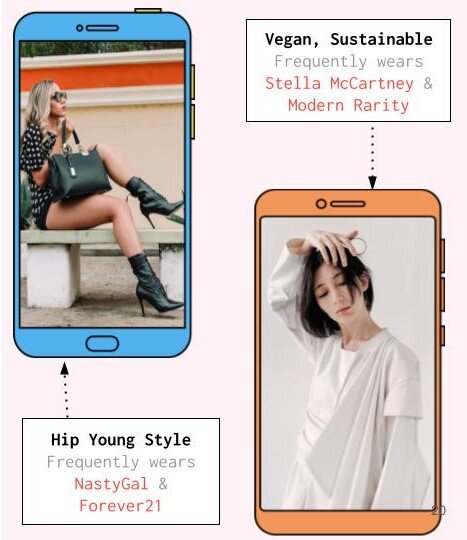
The influencer selected also needs to be great at creating content for the specific platform(s) where your target buyer is most likely to spend time. For instance, a food blogger who creates amazing-looking flat lays for Insta may not have the same knack for creating entertaining TikToks, and the entertainment factor is a huge part of TikTok culture.
An influencer should stick to creative concepts that support the messaging needed to push your target buyer deeper into your funnel and/or farther along on the purchase path.
One thing you’ll want to remember about your influencer selection process is that it’s also important to take a look at the targeted audience’s behavior. By looking at the behaviors of audience members who are actually liking and commenting on an influencer’s posts, you can refine your targeting even more. Huh?
We have an entire post dedicated to influencer outreach penned by our Director of Account Managers. If you want to know how to approach influencers for collabs, that’s the post you want to read. Even has email influencer marketing strategy templates.
Click the big, pretty button below to read that one.

Identifying your campaign goals and understanding who is in your audience determines how we structure influencer marketing strategy campaigns to get specific outcomes
→ which helps you pinpoint the best platforms to use to reach your customers
→ which then dictates the types of influencers we need (and the superpowers they need to have to make your campaign deliver on KPIs).
And of course, all of this shapes the kind of content that influencers will create for your campaign.
There’s a caveat here because a BIG part of what we provide for our clients has to do with the creative concepts our influencer marketing strategy team comes up with to help guide and shape the direction of the influencers’ content.
Our Account Managers serve as the bridge connecting the brand’s desired KPIs with influencers who are best equipped to deliver. One of the ways we do that is by building out creative concepts BEFORE we even select any type of influencers for our influencer marketing strategies.
Specifically, as it relates to your content strategy, influencer marketing has some pretty compelling benefits:
Scale content creation by outsourcing it to an army of influencers.
Expand your visibility by aligning influencer selection with keyword research so you have a diverse group of creators building content specifically designed to target different long-tail keywords.
Amplify your message by bringing in creators who are also raving fans who can promote content and increase the likelihood of making your content go viral.
Prove your value by leveraging the Domain Authority of your influencer partners and adopting their endorsements as much-needed social proof.
Securing Content Rights
We know it’s not fun and it sounds pretty boring, but you have to have a UGC rights contract in place for any influencer marketing campaign strategy.
At our influencer marketing agency, we typically negotiate rights for sponsored content to be used by the brand as they see fit, across their social media channels. But the larger the influencer, the more likely you are to have resistance from the content’s creator. Sometimes that takes the form of an expiration date for the content, or the creator being able to delete sponsored posts from their feed after a certain amount of time… it can get a little weird and a little complicated.
Still, it’s crucial that you iron out those types of details in a written contract because influencers are well within their rights to ask a brand to take down a post that was part of a sponsored campaign the brand has ALREADY PAID FOR if reuse is not clearly defined within the contract. In an absolute-all-out-worst-case-ever scenario, the influencer could actually sue for copyright infringement.
Clarity and transparency are KEY in negotiating UGC rights, both for brands and Creators. Creators need to know from brands exactly how sponsored content and other UGC will be used and how long that content will be used for that purpose.
To ensure a smooth influencer marketing campaign strategy process, always include a section in your influencer contract outlining when an influencer can take down sponsored content, and clearly state that you reserve the right to remove any content an influencer produces for your brand.
Influencers can be particular about the content they leave on their feeds. If you’ve ever looked at an influencer’s Instagram, you know that they’re selective about how much-sponsored content they have on their page.
And duh! This makes sense. You don’t want to see sponsored post after sponsored post – it will ruin their authenticity with their audience.
Brands, on the other hand, also need the authority to take down or remove content that doesn’t meet the established brand guidelines. You can’t have bad or misaligned content that you paid for hanging out on the internet.
To create an effective influencer marketing strategy without any problems, you need to get influencers to agree they won’t infringe on any other person’s rights or copyright. Influencers should not incorporate the pictures, content, audio, or video of another creator’s work into any campaign. That’s uber-important.
To ensure you get what you paid for, we always list a set of DOs and DON’Ts because influencers (bless their hearts) will inevitably do weird things. So, you need a record of the hashtags to be used, any people or things that need to be mentioned in sponsored posts and the length of time the post is to stay published to a creator’s site or social channel.
Contracts also include things like confidentiality clauses that require influencers to keep your super-duper top secret secrets a secret… and indemnification that keeps you out of court in the event a zombie apocalypse, Yeti appearance, or freak accident happens during the creation of the sponsored content during an influencer campaign.
Contracts are crucial, and the details you include in your contracts can save you time, reputation, and tens of thousands of dollars in litigation. Our iron-clad contracts allow our clients to have stress-free campaigns…but trust us when we say every clause in our contract was the result of a hard-learned lesson.
How to Get the BEST Creative Content from Your Influencer Partners
Okay. Buckle up.
If you want great content from your influencer marketing push, you’re going to need really great influencer marketing strategies (plural) that you can provide the influencers.
Building out the strategies for an influencer marketing campaign involves several important elements: knowing who you want to target, knowing where they hang out online, understanding how they shop, and having a solid grasp of the buyer personas the brand wants to reach with the campaign. Those three elements form the comfy cushion upon which your strategists can unleash their creativity.
Strategists?? Yeah… that’s the thing…
We know a lot don’t have designated creative strategists who come up with cool influencer marketing ideas for a living. Something like a third of the marketers asked still struggle to come up with creative ideas for their influencer marketing campaigns (and you say #basic product post?).
If you’re not bringing us on to dream up the concepts (because we actually have strategists), the fix for this is to take a group approach to your influencer marketing campaign strategy and dream up some creative influencer marketing ideas that perfectly align with your voice, style, values, and aesthetic.
Your influencer marketing strategy should have two important elements: a way to get your customers to take the next steps on the path to purchase, and specific, measurable goals to let you know your customers are moving toward a conversion. And since your internal marketing team understands your customers’ path to purchase so well, it’s crucial that they monitor the messaging tied to your influencer campaign.
Take CBD, for instance: In 2019, when CBD was trending everywhere, High Yield Insights released a report which contained a chart of the five buyer personas most likely to purchase cannabidiol (CBD) products.
The personas varied greatly in their demographics and psychographics, which, of course, means marketers have to reach them in different ways and with different messages.
Just so you can see what we’re talking about here, we pulled a few characteristics from three of those buyer personas.
Which would resonate with a message on pain relief? Skincare? Who would you be able to reach on Instagram? Facebook? TikTok?
Campaign Management
If we take a high-level view of an influencer marketing campaign strategy, there really are enough bells and whistles and cogs and doodads to keep a significant portion of your marketing team busy.
Contrary to popular belief, running an influencer campaign isn’t a set-it-and-forget-it type of thing. Because…
Even if you give influencers 100% creative control and plan to approve anything and everything they send you, you’ll still need a few people handling the logistics of managing a campaign and making sure the influencer marketing strategy compels your audience to take the actions you want them to take.
Many of the problems that brands have with their campaigns can be traced back to the team (or lack of a team) running that campaign. In order for your influencer marketing campaign strategy to perform optimally, you need team members who will be taking ownership of some really important tasks such as:
- Finding influencers
- Heading off influencer fraud
- Sending products out to influencers
- Maintaining brand safety
- Coming up with creative concepts and strategies
- Maintaining the timeline
- Setting up tracking pixels (for affiliate links)
- Ensuring influencers adhere to FTC regulations
- Adapting strategies to algorithm changes
- Integrating new features on social if they’ll help your campaign
- Optimizing campaigns

Which is the topic of this section – how to create an influencer marketing strategy that delivers better and better results from the influencer campaigns you run.
Which Metrics Should You Track with an Influencer Campaign?
Without fail, that’s the question brands (and especially CMOs and VPs) want to know before, during, and after their influencer campaign. Which metrics will move the needle for our brand?
You and I both know that influencer marketing was darn near overrun by fraud a few years ago when brands were hellbent on only partnering with influencers who had the most followers and engagement, both metrics that can easily be gamed.
The hit list of metrics you want to watch during an influencer marketing strategy campaign includes these:
Post Engagements – The number of likes, comments, and shares on a post
Engagement Rate – Post engagements / total number of followers * 100
Story Views – The number of times a user has viewed an Instagram story
Story View Rate – Story views / total number of followers * 100
Post Video Views – The number of times a user has viewed an Instagram video post
Replies, Shares, Profile Taps, Link Clicks – The various actions a user can take on Instagram stories
Post Impressions – The total number of people your content is visible to
Post Reach – The total number of unique people who see your content
Clicks – The number of actions taken on a post in the form of a click to a designated URL. Clicks are counted through link in bio, swipe up, post links, etc.
Unique UTM links – These codes added to the end of a URL track clicks and performance of marketing activities
Tracking Pixels – Used for blog content, these snippets of code allow you to gather information about visitors on a website (how they browse, what type of ads they click on, etc.)
Brand Sentiment – How relevant was the branded content to the influencer’s audience and did the branded content actually resonate with the audience (ie: commenting on the outfit vs. the brand sponsorship or messaging)
And the preferred metrics for this list can shake out a number of different ways depending on your influencer marketing campaign strategy goals.
Optimizing Influencer Marketing Strategies for Better ROI
One of the great things about running an influencer campaign is that you’re able to tweak live influencer marketing campaigns as they’re running and keep an eye on the metrics listed above in [relatively] real-time. That means you can make changes to the content, messaging, visuals of your campaign, and even your overall influencer marketing strategy as already-live posts deliver the insights you need to keep your campaign performing well.
Optimization allows you to use influencer-generated sponsored content to target the exact audiences that are most relevant to you, directly from the influencer’s account. This supercharges social proof because endorsements come directly from the influencers’ accounts, not the brand’s account.
Create an optimization framework that you can use as a roadmap to continually improve on the results of a LIVE campaign and deliver data that can have profound effects across ALL of your marketing channels.
#1 CTA
What is a CTA? Call to Action- A button or request for users to do something, to take some type of action.
Why a CTA is important: Establishes connections, results in a conversion, expands customer reach, motivates your audience.
CTAs are only as good as the concepts with which they are combined.
- Giveaways
- Promos
- Philanthropy
- Store newsletter signups
- Store rewards program (encouraging participation)
#2 CONCEPTS
What are campaign concepts: Brand-safe creative ideas that make people want to engage with your campaign content.
Why concepts are important: They are crafted to help the brand accomplish specific marketing goals.
- Artistic Concepts
- Informational
- Reward Based
- Quizzes
- Digital “Parties”
- Community Content
- Real / Relatable
- Aspirational
#3 Post Type
What are post types: Post types refer to the combination of media formats + platform features.
Why post types are important: Posts are the expression of the creative concepts fueling an influencer marketing campaign. Concepts should be matched with the post type that most effectively compels the targeted audience to take action.
- IG Photos
- IG Videos
- IG Stories
- IG Reels
- Youtube Videos
- YouTube Stories
- YouTube Shorts
- Facebook Live
- Facebook Watch
- Pinterest Pins
- Pinterest Stories
- TikTok Videos
#4 VERTICALS
What are verticals: Verticals are segments of your target audience identified by their commonalities.
Why verticals are important: Identifying and optimizing content for different verticals is crucial for an influencer marketing strategy and helps to really nail campaign targeting, causing your messaging to be more effective.
- Fashionistas
- Gen Z social
- Shoppers
- Moms with a plan
- Adventurers
#5 INFLUENCERS
What are influencers: Social media users whose followers look to them for advice and guidance on specific subjects.
Why influencers are important: Knowing which influencers have the greatest impact radius will help you fine-tune your messaging and optimize the content that performs best.
- Micro (IG)
- Mid (IG)
- Macro (IG)
- Large Vloggers
#6 DISTRIBUTION
What is distribution? Distribution entails getting a greater reach for the top-performing content in your influencer marketing campaign strategy.
Why distribution is important: Knowing which pieces of content are working for the campaign lets you put more resources behind that content to reach more people for better ROI.
- Organic reach
- Boosting
- Dark-boosting
- Amplification
- Facebook Groups
- Newsletters
The sponsored content influencers generate for your campaign can be repurposed and reused across different channels. Doing so extends the life and value of your campaign content and enables your influencer marketing strategy to deliver returns for years to come.
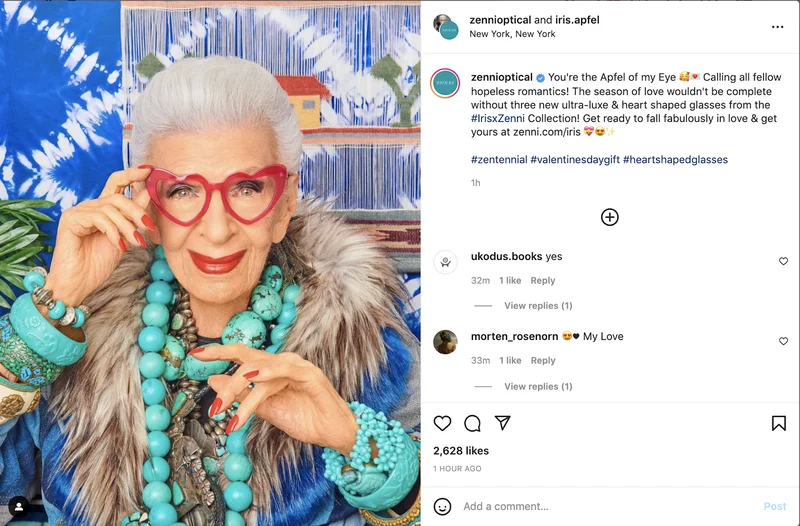
Instagram feed post of Iris Apfel x Zenni Optical collab
As little as 16 percent of brands have influencer marketing strategies for incorporating user-generated content (UGC) even though a quarter of search results for large brands are linked to UGC and other content not created by the brand itself.
Instagram story introducing the Iris x Zenni collab
A Few Things to Keep in Mind
Before you reuse any influencer content, make sure you have permission to do so to protect your social media influencer marketing strategy and campaign.
Plan ahead. Draft an influencer marketing strategy plan for how you’ll incorporate influencer content into your social content calendar.
Mix in influencer content with your traditional branded content. Remember: Balance is key.
Yes, you still have to tailor the content to the channel. No copying-and-pasting, y’all. Reformat assets to platform specs, and craft unique captions/post text.
Try out different methods of reusing, and multiple formats. Alternate between resharing, reposting, and repurposing (defined on the following slides).
Not all influencer content will be great for your pages. Reuse only high-quality content that is representative of your brand and/or compliments your existing brand aesthetic.
You have options. You’ll usually have more content from each influencer than just what gets posted to their feed. So, you can use similar content for retargeting or different posts altogether for different parts of your funnel. Check out the reuse of the above Instagram post from Iris Apfel ☝🏼 to this screenshot 👇🏼 of Zenni Optical’s website homepage.
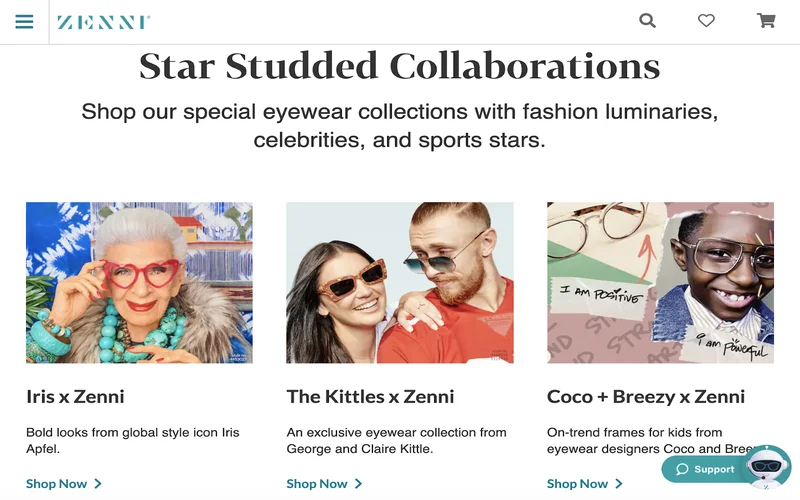
Reshare, Repost, and Repupose Influencer Content
Quite simply, when your page SHARES the influencer’s original post from their page to yours.
Note: this is frequently referred to as “sharing” a post, and sometimes – to make things equally confusing – reposting a post. Typically we don’t need to make such clear distinctions between re-share and repost, but for the purpose of creating a clear, precise article with explanations for you, we’re gonna harp on this for about 20 more seconds.
Defining Elements:
→ You do not upload a new asset to your post before RE-SHARING it
→ The post on your page appears as a SHARE rather than a photo or video.
→ RE-SHARES can only occur on the same platform on which the original post was published.
Examples of Ways to Reshare Influencer Content
- Reshare an influencer’s live FB video broadcast onto your brand’s page to increase engagement rate
- Re-share influencer giveaway posts published on their Instagram feed to your IG story to notify your existing followers of the giveaway and tell them how they can enter
- Help amplify an influencer’s video published to Facebook Watch by sharing it to your page with a meaningful caption
- Embed influencer social posts of any type in your brand’s blog posts
- When an influencer tweets a link to their sponsored blog post, “favorite” the tweet and then retweet it with a comment
- Create a playlist on your brand’s YouTube account that is only for influencer YouTube videos. Add their videos (uploaded to their YouTube channel) to the playlist
Level:
👶 Beginner – Easy peasy, lemon squeezy.
A new post published to your page that looks as though it was “reposted” from an influencer’s page.
Create a REPOST by uploading the influencer’s asset to your post and pair it with quoted text from their original post caption.
This influencer marketing strategy will generate brand awareness and expand your reach.
Defining Elements:
→ The post appears as though you REPOSTED an influencer’s original post and added a sentence or two to the caption before doing so
→ REPOSTS are confined to the channel the original post was published to.
When a brand takes the influencer’s assets, optimizes them for the channel, and then posts them directly to your page(s) with an original caption.
Examples of Ways to Repost Influencer Content
- Quote an influencers’ product review (or something they’ve said about your products in one of their post captions) in a tweet and tag them for credit/as the source
- Repost an influencer’s Instagram feed giveaway post to your page with a caption outside the quoted text telling your followers how to enter the giveaway on the influencer’s page
- Have influencers submit additional assets + captions for an Instagram or Story takeover on your brand page, and post them to your page on their behalf on the day of the takeover (have them cross-promote the takeover on your page so their followers know to go check out the content!)
- When an influencer posts to their Story and links to a sponsored blog post, do the same on your page (upload the asset and link to the blog post in the swipe up) rather than re-sharing their original story to yours (see Grove Collaborative repost example)
Level:
😎 Intermediate …But still pretty easy.
When a brand takes the influencer’s assets, optimizes them for the channel, and then posts them directly to your page(s) with an original caption.
Defining Elements
→ REPURPOSED POSTS can occur on any platform, regardless of where the original post was published to.
→ REPURPOSED POSTS include totally original captions (written by you) and multi-asset posts can feature assets from multiple influencers (if app.).
→ Creativity is key!
Examples of Ways to Repurpose Influencer Content
- Use influencer assets in ads that promote a new product launch or on product detail pages
- Feature influencer photos as “proof points” in abandoned cart reminders (“We noticed you still have X in your cart! So and so loves their X – here’s what they said about it…”)
- Chop up influencers’ videos and string together into one that tells a story about your brand from your influencers’ perspective, and post it to Facebook Watch or YouTube
- Get your influencers to create product demo videos they don’t post to their pages that you can feature on product detail pages on your website
- Include influencer assets in e-books or another type of downloadable/gated content
- Create quote graphics using part or all of an influencer’s caption/comment about your product(s) and post it to your social pages
Level:
💪 Advanced-ish – Requires some thought & planning.
We created an entire influencer marketing strategy guide just on repurposing influencer-generated content. Click the pretty button below to read up on best practices.

Influencer Marketing Definitions
Reach – Influencers’ follower count at the time of posting
Unique Reach – Campaign-wide metric that means the sum of all influencers’ follower counts across platforms
Total Potential Reach – Influencers’ follower count x Total number of posts
Impressions – Total number of times the content is viewed on Instagram. This can come from the influencer’s profile, scrolling on Instagram, searching hashtags, etc. (IG does not identify how many seconds qualifies)
Authenticated Total Impressions – Sum of all story views (called impressions) across all story frames
Engagements – Number of interactions on post (i.e. comments, likes, link clicks, shares, replies, profile visits, sticker taps)
Total Engagements – Likes + comments: sum across all posts (Stories: Link clicks, shares, replies, profile visits, sticker taps: sum across all frames)
Engagement Rate (ER) – Authenticated total engagements divided by total potential reach
IGC – Also called influencer-generated content, it’s the total unique images and/or story frames created for a campaign. Also referred to often as User-Generated Content, or UGC.
Avg. Platform Engagement Rate – Average engagement rate from ALL the influencer’s posts in last 60 days minus the last 15 days (the last 15 days are subtracted as new posts are still gathering engagement)
Campaign Platform’s Engagement Rate – The overall engagement rate for the campaign as a whole (total engagements from all campaigns posts divided by the total potential reach of the entire campaign)
Impressions/Reach Rate (IG Story Stats) – Auth. total impressions divided by total potential reach
Engagements Rate (IG Story Stats) – Total engagement ÷ auth. total impressions
Authenticated Total Impressions / Impressions – Sum of all story views across all frames
Total Aggregate Follower Counts / Total Potential Reach – Influencers’ follower count x total number of posts
Whitelisting – Using obtained permissions from influencers to run paid ads through their identity. (See the example in the whitelisting section)
CPC – Cost per Click: Your total digital spend, divided by your total number of clicks
CPE – Cost per Engagement: Your total digital spend, divided by the number of paid engagements
CPM – Cost per 1,000 Impressions: Your total digital spend, divided by your total paid impressions, then multiplied by 1,000
Sticker Taps (on Stories) – A sticker is a design element that can be added to images or videos on Instagram to give context to posts. Stickers are usually things like related hashtags, @mentions, and locations.
They can also be more interactive things like quizzes, donations, polls, and emojis. Now you can even include links in stickers. So, sticker taps are responsive taps to the stickers on a post to show interest in the content. Total clicks on Influencers’ “story stickers” is an important indicator of campaign success.
Swipe-Up – A swipe-up happens when a social media user slides their finger from the bottom of a Stories post to the top to find out more information, go to a sales page, or engage with social media content in another way. Swipe Up to Buy or just Swipe Up is commonly used in Stories as a call-to-action
Link Clicks (on Stories) – Total times someone swipes up on an influencer’s swipe up link or clicks on a sticker with a link.
Profile Visits (on Stories) – Total clicks to an influencer’s profile from story slide
Replies (on Stories) – Total replies to an influencer’s Instagram story using direct messaging
Shares to Stories – Instagram can share in-feed posts of other users by posting them to their own Stories for 24 hours.
Views – A view is a predetermined number of seconds a user allows a video to play. This magic number differs from platform to platform.
Clicks to Branded Pages – On Instagram, clicks to branded pages happen when users either click the branded link in an influencer’s bio, the link in a story sticker, or swipe up to go to the landing, sales, or product page of a promoted offer.
Influencer Marketing Stats and Benchmarks
Blogs
- 70% of consumers would rather learn about a company from a blog post than an advertisement (Source)
- 72% of blog readers would rather watch the recap video than read the blog
- Internet users in the US spend 3X more time on blogs than they do on email. (Source)
- 59% of people will share an article without reading it first, or ever. (Source)
SNAPCHAT
- 293 million people use Snapchat each day. (Source)
- On average, people spend 34.5 minutes per day on Snapchat and send 34.1 messages a day. (Source)
- The average Snapchat user opens the app more than 30 times a day (Source)
- 82% of Snapchatters are 34 years old or younger. (Source)
- Pinterest has more than 444 million active users. (Source)
- 85% of Pinners say Pinterest is where they go to start a new project. (Source)
- 80% of weekly Pinners have discovered a new brand or product on Pinterest. (Source)
- 98% report trying new things they find on Pinterest. (Source)
- 23% of those on Facebook daily have purchased something from an influencer/blogger recommendation. (Source)
- 73% of U.S. Facebook users check the platform daily, and 93% use it weekly. (Source)
- Facebook is the third most-visited website after Google and YouTube. (Source)
- Facebook users spend 38 minutes a day on the platform, on average. (Source)
- 1 in 4 Gen Z and Millennials actively seek stories of products and services they are considering buying. (Source)
- 500 million users view Instagram stories daily. (Source)
- 50% of users say they’ve bought a product they discovered on Instagram. (Source)
- Instagram users spent an average of 30 minutes per day on the platform in 2020. (Source)
- 40% of those on Twitter daily have purchased something from an influencer or blogger recommendation. (Source)
- 87% of Twitter users also use Facebook, and 84% also use Instagram. (Source)
- Promotional content from influencers yields a 5.2X increase in Twitter users’ purchase intent. (Source)
YOUTUBE
- Video content is 50X more likely to drive organic search traffic than plain text. (Source)
- One quarter of daily Youtube users have purchased something from an influencer or blogger recommendation. (Source)
- 90% of global shoppers say they discover new brands and products on YouTube.
- 70% of consumers in the US, Mexico, and Colombia have purchased a product after seeing it on YouTube. (Source)
TIKTOK
- In less than 18 months, the number of US adult TikTok users grew 5.5 times. (Source)
- Half of TikTok’s global audience is under the age of 34 with 32.5% between 10 and 19. (Source)
- TikTok users spend an average of 52 minutes per day on the app. (Source)
- 49% of US teens have used TikTok, compared to 9% of Americans overall. (Source)
- Half of TikTok users say they’ve shared someone else’s TikTok on another social network. (Source)
Let This Be a Starting Point
Interested in more data-fueled insights to build your influencer marketing strategy? Check out 111 Influencer Marketing Stats. It’s frequently updated and a great source of insights and info that will give you a great overview of the influencer marketing strategy space.
Plus, this post is loaded with links to good sources to provide you with a more in-depth understanding of the influencer marketing strategies covered in this guide and offer valuable tips for developing successful influencer marketing campaign strategies.
Or if you’d rather talk to a human, we have a couple here who are pretty awesome. Our influencer marketing strategy services can help you run campaigns shaped by data-driven insights.



